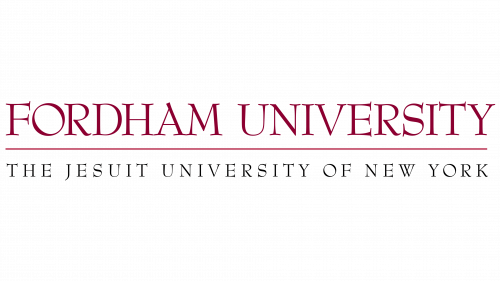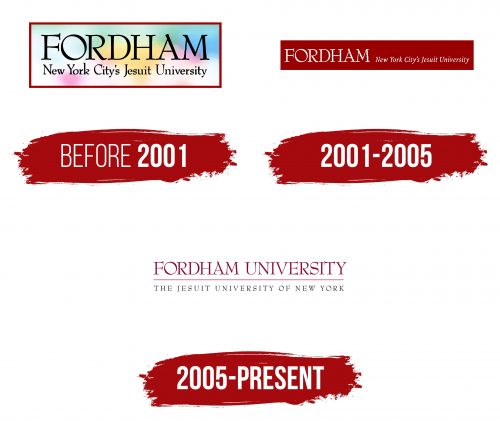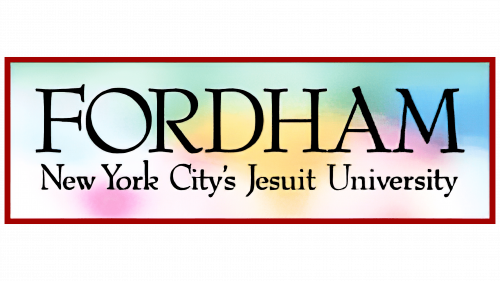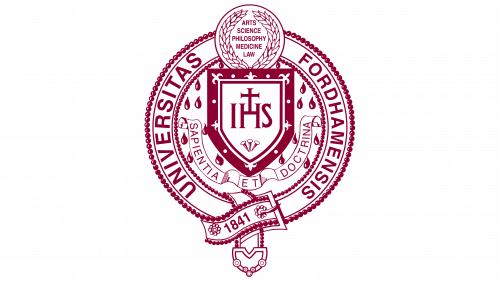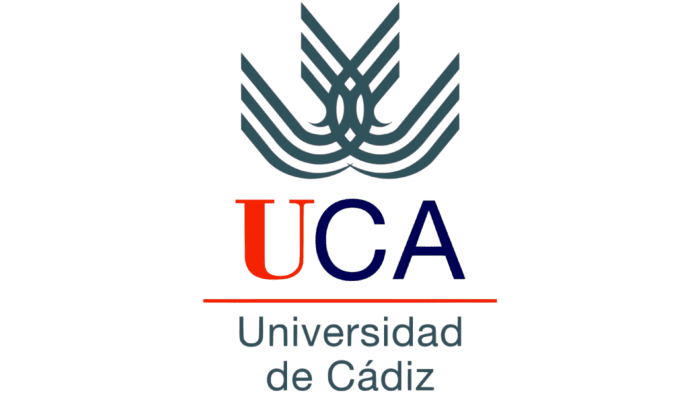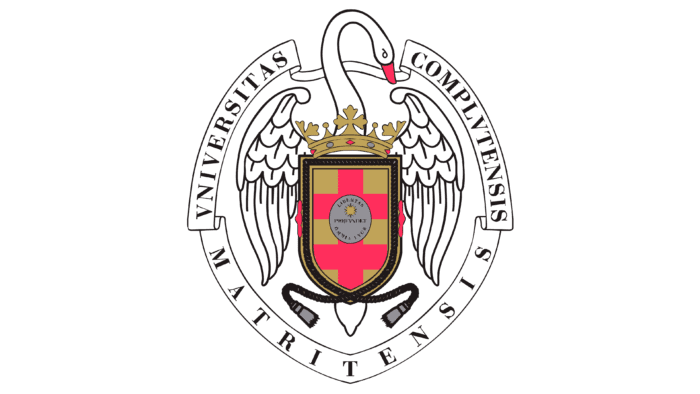The Fordham University logo is a light and refined symbol that reflects the significant impact the university has had on the state’s history. This mark symbolizes knowledge, which guides one on the right path and illuminates life’s journey, helping to find truth. The emblem emphasizes the university’s role in shaping educated and enlightened individuals, ready to contribute to society and preserve the traditions that are the foundation of the institution’s success.
Fordham University: Brand overview
In the Bronx’s Rose Hill neighborhood, Bishop John Hughes of New York established St. John’s College in 1841, marking the beginning of Fordham University’s history. Catholic students, who at the time frequently experienced discrimination in other educational institutions, were given access to a classical education through the founding of this institution.
The first few years of college were difficult. Low enrollment and financial challenges beset the college. However, the institution overcame these challenges because of Bishop Hughes’ tenacity and the backing of the Catholic community.
The State of New York granted St. John’s College an official charter in 1846, enabling it to award degrees. This crucial step was necessary for the college to gain recognition and solidify its place in the educational community.
The college saw substantial expansion in the 1850s. One of the new structures built was the Church of St. John the Baptist, still a key component of the Rose Hill site.
1859, the Society of Jesus (Jesuits) became the college’s administrative body. This choice brought Jesuit educational traditions, which are still a significant component of the university’s identity today and significantly impacted the institution’s development.
The Civil War made the 1860s a difficult time. The number of staff members and students who departed for the war temporarily declined the institution’s operations.
St. John’s College was renamed Fordham University in 1870 to reflect its neighborhood. The university is situated next to a short Bronx River crossing, and the name “Fordham” is derived from the Old English terms “ford” (a shallow crossing) and “ham” (village).
The university experienced substantial growth in the late 19th century. In 1905, two new faculties were established: law and medical schools. These expansions greatly expanded the university’s academic offerings and enhanced its standing.
Early in the 1900s, the institution kept growing. With the opening of a campus in Manhattan in 1912, the institution was able to increase its visibility right in the middle of New York City.
The university continued to expand throughout the 1920s and 1930s. During this period, the School of Social Service was founded in 1916, and the School of Business was founded in 1920, increasing academic offerings.
Like many other universities, it participated in military training programs during World War II. The establishment expanded quickly following the war due to the flood of soldiers entitled to free tuition.
The 1960s were a time of major transformation. With the admission of more women and students from a wider range of ethnic backgrounds, the institution expanded its reach and inclusivity. Graduate programs were also expanded during this period.
In the 1970s and 1980s, the establishment continued to update its programs and facilities. Opening new research centers and institutes enhanced the institution’s standing in scientific research.
Large sums of money were invested in the growth of the campuses in the 1990s and 2000s. New academic buildings, residence halls, and sports facilities improved conditions for teachers and students.
The institution increased its global reach in the 2000s by growing its exchange program and establishing a study center in London. This made it possible to provide students with a more extensive international education.
“Excelsior | Ever Upward | The Campaign for Fordham,” an extensive fundraising drive started in 2010, raised over $500 million by the end of 2014. These funds supported research projects, extended scholarship programs, and upgraded infrastructure.
2011 saw the opening of a new School of Law facility in Lincoln Center, greatly enhancing living quarters for law students and solidifying the university’s standing in the field of legal education.
The Fordham Foundry, an incubator for student enterprises, opened its doors in 2012 because the institution was growing interested in supporting student entrepreneurship.
With the opening of McKeon Hall, the new student center, in 2014, living and studying conditions for students in the heart of Manhattan were greatly enhanced.
2015 saw the expansion of foreign programs. The institution increased the options for student exchanges and international internships while fortifying its connections with foreign academic institutions.
A new center was opened to further advance cybersecurity research, and new courses in the subject were instituted in 2016.
In 2018, the Rose Hill campus received a new STEAM (Science, Technology, Engineering, Arts, and Mathematics) center, which enhanced its standing in multidisciplinary research and teaching.
The university unveiled a comprehensive plan in 2019 to modernize the existing facilities and create new academic buildings as part of its extensive plan to expand and refurbish the Bronx campus.
2020 was a year of swift adjustment to unanticipated circumstances. The institution successfully made the switch to a hybrid learning paradigm by blending online and classroom instruction, as well as by increasing its capacity for remote learning.
In 2021, the institution expanded its social justice and equity programs by introducing several measures to foster a more inclusive and diverse campus community.
In 2022, research efforts experienced a notable expansion, focusing on artificial intelligence, urban studies, and global health.
The university launched multiple new online master’s programs in 2023 as part of its ongoing efforts to expand its online offerings in response to the increased demand for flexible learning options.
The institution has always maintained its Catholic and Jesuit heritage while expanding its scope of study and research to meet the demands of a changing society. From a tiny Catholic college, it has expanded into a significant research institution that is now deeply involved in the cultural and educational world of New York City and the nation.
Meaning and History
What is Fordham University?
This university, located in New York City, is a highly respected private Jesuit research institute. It offers undergraduate and graduate programs in various fields, including liberal arts, sciences, business, law, and social services. The university is known for its challenging academic programs and commitment to the Jesuit tradition of education. The university’s main campus is Rose Hill, Bronx, with other Manhattan and Westchester County campuses. It is known for its emphasis on social justice, ethics, and community service and incorporates these principles into its academic program and the lives of its students. The university’s location in New York City provides students exceptional networking opportunities, cultural experiences, and internships. The university has made a name for itself by combining a traditional liberal arts education with cutting-edge professional programs. This has helped students become leaders in a wide variety of industries.
Before 2001
The first emblem of the university appears quite unusual for an educational institution, especially considering the strict Jesuit traditions on which the university is founded. The logo includes a multicolored gradient placed within a red frame, which is not typical for university symbolism. Such a design might seem unexpected, given the seriousness and conservatism of the educational institution.
Despite its appearance in 1907, the emblem may have been designed later when St. John’s College was renamed Fordham University. The gradient background might be associated with the name of the first campus, Rose Hill.
The name Fordham comes from the village where the first academic building was constructed. The logo’s sharp blue serif lettering gives it a celebratory look. Below the main name is a clarification that it is the Jesuit University of New York.
Overall, the emblem might seem more fitting for a fashion company than for a Catholic university, which adds to its uniqueness and makes it stand out among the traditional logos of other educational institutions.
2001 – 2005
In 2001, the university logo was changed to a more aggressive and, according to many, disharmonious design. The previous font’s white “Fordham” inscription was placed on a dark maroon background and stretched into a long line. Below it was the explanation: “New York City’s Jesuit University.” However, the varying letter sizes and small text made the emblem visually unbalanced. The maroon background color, supposed to symbolize the blood of Christ and noble worship, appeared gloomy and weighed on perception, not meeting expectations for university branding.
2005 – today
The logo of Fordham University, introduced after the merger with Marymount College, reflects the institution’s rich history and prestige. The main element is the “Fordham University” inscription in a thin maroon font with elegant serifs. This color symbolizes the university’s traditions and academic significance, emphasizing its long-standing presence in the educational sphere.
A thin horizontal line runs below the main inscription, dividing the logo into two parts. Below the line is the text “The Jesuit University of New York,” written in small black font, adding a sense of strictness and elegance to the logo. This design reminds us of the university’s Jesuit roots and important role in New York’s educational system.
The combination of maroon and black creates a sense of sophistication and depth, highlighting the institution’s status as one of the oldest and most respected in the region. The logo is done in a minimalist style, making it recognizable and modern while respecting the university’s long history, whose origins trace back to the Rose Hill campus, where the university was founded.
The Seal
The university’s seal is surrounded by a circle, symbolizing the “belt of truth.” The buckle displays the date of the university’s founding, emphasizing its historical significance. The belt is adorned with beads along the edges, adding a spiritual accent. Blood drops in the seal’s background symbolize Christ’s sacrifice, consecrating the university’s mission.
At the center of the seal is a heraldic shield decorated with fleur-de-lis, symbolizing purity and faith. Inside the shield is the symbol of the Jesuit order, a central element of faith. Three nails at the shield’s bottom represent Christ’s suffering and the struggle against sin. Below the shield, on a heraldic ribbon, is engraved the Latin inscription: “the wisdom of teaching.”
Above the shield is a crown, which lists the fields of study: art, science, philosophy, medicine, and law. This element emphasizes the university’s wide range of educational programs and its commitment to the comprehensive development of students.
